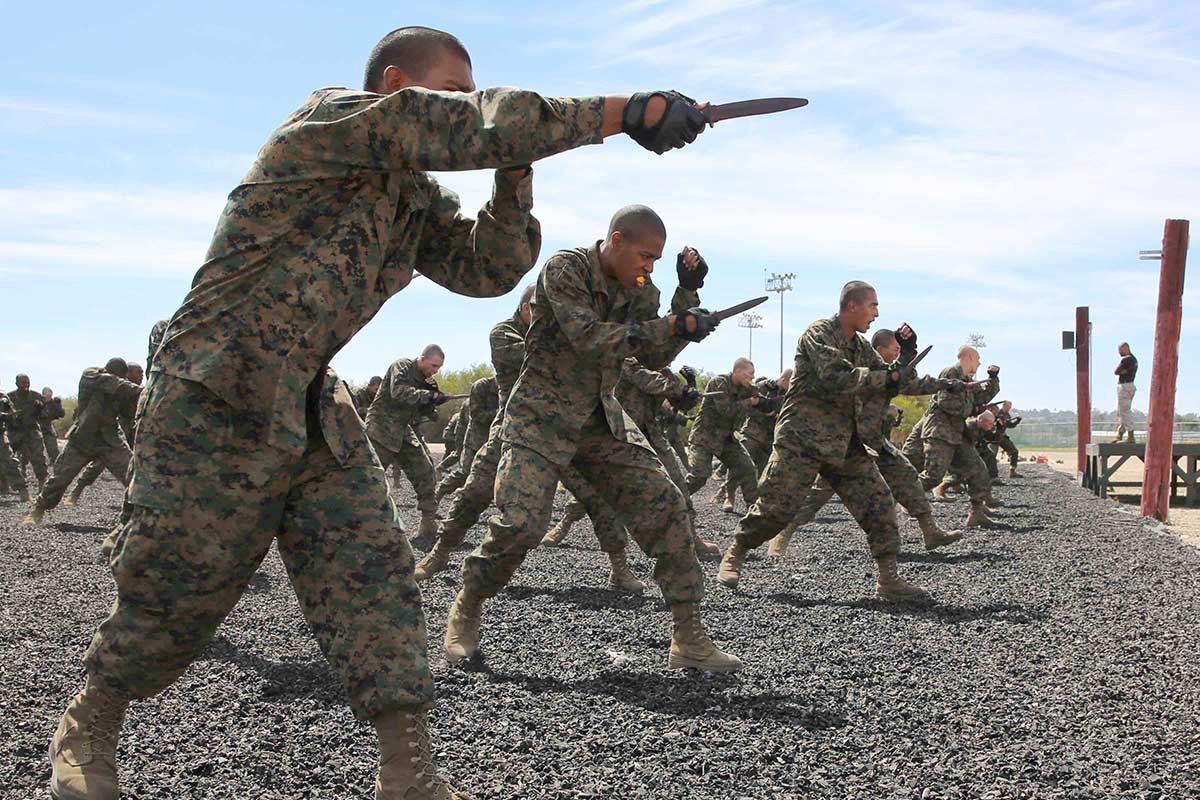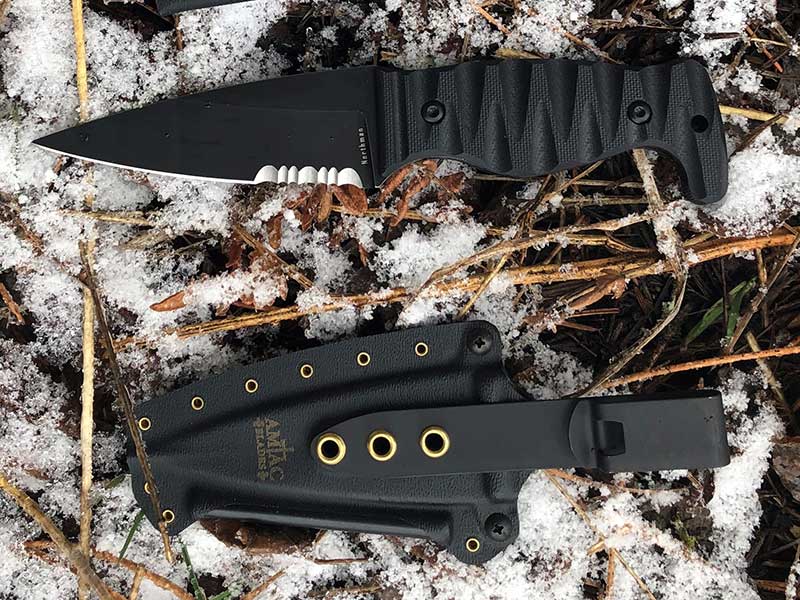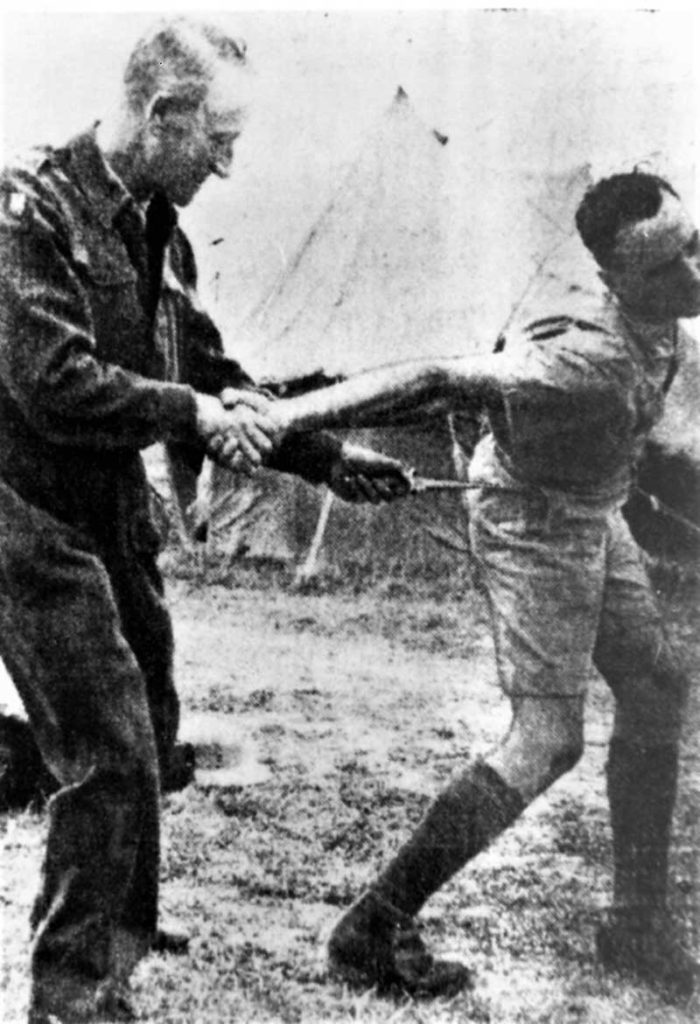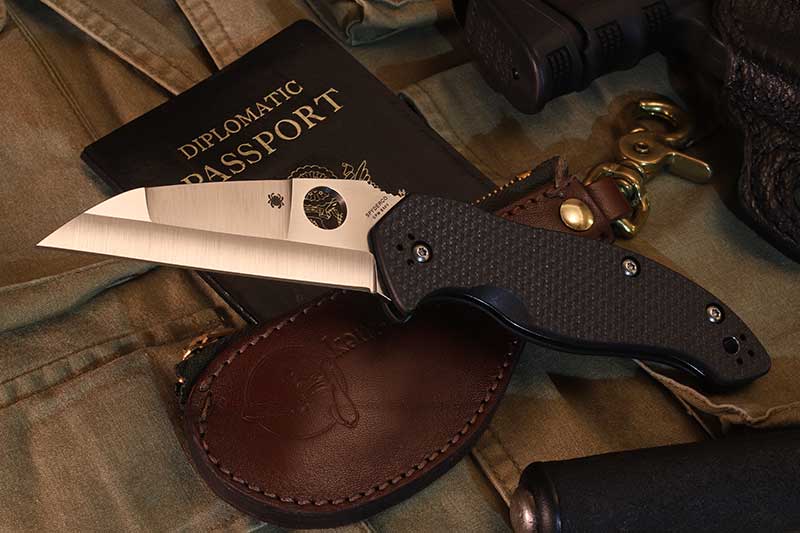
AC-032921-Combatives-IC-1-800
Although the primary reason law enforcement officers (and most people) carry knives is for their everyday utility applications, they have an important role to play in the defensive weapon toolbox, as well.
We have all heard it said “never bring a knife to a gunfight.” While there’s certainly truth to that statement in so far as always having a gun as your primary lethal weapon, having one doesn’t rule also having the other. There’s a need for both. Edged weapons have a place in a lethal force encounter. Don’t make the mistake of thinking that all you need is a gun. That’s a mistake that can easily get you killed.
We need to prepare for all contingencies. In a close quarters lethal force encounter, we may not have the time or ability to deploy our firearm. Empty hand, knife and gun need to be (or become) an integrated skill set. It’s a force multiplier.
FIXED BLADE VERSUS FOLDER
Although folders are by far the most popular knives for everyday carry (EDC), a fixed blade knife has some key advantages (where legal to carry) over folders for self-defense. These include ease and speed of deployment utilizing only gross motor skills, and no locking mechanism to potentially fail.
Veteran law enforcement officer John Benner, President and Chief Instructor of the Tactical Defense Institute (TDI), teaches the use of both fixed blade knives and folders in the Institute’s law enforcement knife class. A balloon drill is done as part of the class.
In the drill, the student deploys a knife to break a balloon while being timed on a shot timer. According to Benner, the average student can deploy a fixed blade knife and break the balloon in one second or less. While the fastest officer with a folder takes 1.5 seconds, times can run up to ten seconds “fumbling around.”
Grip is also an issue. Benner also states that when that when the folder hits the balloon in his classes, most of the officers lose the knife if they hit a hard object, since they don’t have a good grip.

AMTAC Blades Northman is a small fixed blade knife designed by former U.S. Navy SEAL and DEVGU operator Bill Rapier that carries in a pocket like a folder. It’s designed for both combatives and utility/backcountry.

A training knife allows you to work with a partner and provides safe and realistic close-contact distance training. AMTAC Blades Northman Trainer is designed to replicate the live blade and comes with a storage sheath that can be used to hold the live blade while using the Trainer. Photo: AMTAC Blades
With a fixed blade knife, it’s not necessary to transition from an opening grip to a different grip for fighting. You can acquire a proper grip during the draw. The differences in speed and gripping ability between a fixed blade knife and a folder are substantial in a stress-free training environment. The differences become even more apparent when you are fighting for your life. Given the option, I will always go with a fixed blade as my primary defensive/fighting knife.
Folders do have some pluses that may override other considerations for some people and in some circumstances. They’re socially acceptable and legal to carry in more places. They’re smaller and more convenient to carry than a fixed blade of comparable size. And, with the blade closed, a folder can provide less lethal options as a fist load, impact weapon, pressure-point pain-compliance tool and, in some cases, for joint manipulation.
Should you choose to carry a folder for personal defense, either due to departmental regulations or for legal reasons or just simply personal preference, it’s critical that you practice with it until rapid deployment becomes second nature both under stress and from a variety of positions. Folders can be effective fighting tools but they do require considerably more training and practice than their fixed blade counterparts.
The simpler and more instinctive that a knife is to employ and the more reliant that it is on gross motor skills, the more effective it will be in an actual fight.
I generally carry both a fixed blade and a folder. I use the folder for routine EDC utility tasks and as a backup to my fixed blade. And I practice extensively with both.
Training with any knife that you carry is essential. The availability of an unsharpened/blunt training version of the actual carry knife for safe practice is an important consideration when selecting a defensive blade. The closer it replicates the live blade, the better. The trainer provides safe and realistic close contact distance training. It also allows you to work with a partner in practicing these skills.
UP CLOSE AND PERSONAL
Although we are taught to utilize the concepts of “reactionary gap” when dealing with a potential assailant, we deal with people in close proximity all of the time. It cannot be avoided. Most assaults take place up close and personal. We need to prepare and train for this possibility.
Retention shooting is the ability to shoot the bad guy in extreme close quarters (bad breath distances) while retaining possession of your gun. It’s an essential skill for anyone who carries a firearm for personal defense. Integration of retention shooting training with empty hand and knife techniques is equally essential.

Legendary W. E. Fairbairn instructing at Camp X, known officially as Special Training School (STS) 103, the top secret World War II covert operative training school in Canada, in July 1942. Photo courtesy Lynn Philip Hodgson, author of Inside Camp-X.
An excellent example of this type of integrated training is the Pistol Integrated Combatives Course taught by retired U.S. Navy SEAL Bill Rapier, Owner and Lead Instructor of AMTAC Shooting, who spent 20 years in the Navy. His Navy assignments included over 14 years at Naval Special Warfare Development Group (NSWDG), known by the abbreviation DEVGRU or commonly as SEAL Team Six.
The development of a combat mindset is a crucial aspect of training. To quote the legendary W. E. Fairbairn, regarded as the father of modern combatives, “It will soon be found that the principal value of the training lies not so much in the actual physical holds or breaks, but in the psychological reaction which engenders and fosters the necessary attitude of mind which refuses to admit defeat and is determined to achieve victory.” (W. E. Fairbairn, All-In Fighting, 1942)
ACTION VERSUS REACTION
Ballistic motions require a complex sequential interplay between perception, cognition and muscular-skeletal movement. We learn to accomplish predicable ballistic motions by training to forego the feedback process. This is commonly and erroneously referred to as “muscle memory.” The motion is performed smoothly as long as we don’t let other stimuli interfere with the instructional sequence. Speed and accuracy can be enhanced by the repetitive process but within the limits set by neuro-physiological and biomechanical processes.
Action is always faster than reaction. Reaction time is the interval time between the presentation of a stimulus and the initiation of the muscular response to that stimulus. The number of stimuli that are presented, each requiring their own response, is a primary factor affecting response. If there’s only one possible response (simple reaction time) it will take less time to react. If there are multiple possible responses (choice reaction time) it will take longer to react.
Reaction time will increase proportionally to the number of possible responses until a point in which it maintains constant despite the increases in possible responses. This is known as Hick’s Law, named after William E. Hick who discovered it in 1952.
Fitts’ Law, named after Paul Fitts who proposed it in a 1954 scientific paper, is a predictive model that applies to human psychomotor behavior. It’s a formal relationship that models speed/accuracy trade-offs in rapid, aimed movement. Fitts also proposed an index of human performance that combines a task’s index of difficulty with the movement time (in seconds) in selecting the target. Fitts’ Law has been shown to generalize a variety of physical activity and ergonomic situations where speed and accuracy play important roles.

Designed by combatives trainer Greg Thompson, Benchmade 173BK Mini SOCP Dagger optimizes some of the most popular elements of the popular SOCP platform for concealed carry. The finger ring aids in rapid deployment and retention.

Folders can be effective option but require considerably more training and practice. Spyderco Canis was designed by former U.S. Marine Corps Special Operations Officer and combatives trainer Kelly McCann.
Focusing on fewer skills and skills that require less precision will help you to more effectively respond to an unexpected attack. Fewer choices and choices that require only gross motor skills will result in a faster response time. This is a failing of most martial arts.
Most readers have probably heard of the Tueller Drill. It’s a training exercise to prepare against a short-range knife attack when armed only with a holstered handgun. It has its origins with Dennis Tueller, who was at the time a Sergeant with the Salt Lake City (Utah) Police Department.
Sergeant Tueller wondered how quickly an attacker with a knife could cover 21 feet. He timed volunteers to see how fast they could cover the distance to stab the target and discovered that they could do so in 1.5 seconds. The results were first published in a March 1983 S.W.A.T. magazine article titled “How Close is Too Close,” and in a police training video with the same title.
The Discovery Channel television program MythBusters covered the Tueller Drill in a 2012 episode titled “Dual Dilemmas.” The MythBusters team found that with attacks initiated from 20 feet it was possible to shoot a knife wielding attacker when armed with a holstered handgun, but only just as the attacker reached the shooter. At shorter distances, the attacker was always able to stab the defender prior to being shot.
It’s important to keep in mind that in the Mythbusters scenario the subjects were aware in advance of the knife attack and the response (simple reaction time). The reactionary gap would be significantly greater in most real world scenarios.
TACTICS, TECHNIQUES AND PROCEDURES
Although the employment of appropriate tactics, techniques and procedures (TTP) cannot eliminate the reactionary gap, it can lessen it. Split seconds count.
Noted firearms trainer and former U.S. Navy SEAL and NSWDG operator Kyle Defoor of Defoor Proformance Shooting has found that a fixed blade knife is typically one-quarter second faster than a gun in a retention shooting situation. It’s here where empty hand techniques and the use of the blade come into play.
Many of the commonly taught retention shooting techniques rarely work on the street. They may be great on the square range, but can get you killed in the real world. At bad breath distances you’ll need to defend yourself from the threat before you can draw your gun. Forget the commonly taught shove and “speed rock.” At this close distance, the mantra should be fight first and shoot second.
In a lethal force encounter, a knife may be employed to gain physical balance, a dominant body position and leverage or to create space before introducing a gun into the fight. Some examples where this may be necessary are when in a lethal clinch, when attacked from behind, on the ground in a bad body position or thrown over objects. It may also be employed as a weapon retention tool in the event of attempted gun grab.

Training with a blade is an essential part of combative training. Here Recruits of Bravo Company, 1st Recruit Training Battalion, practice the forward thrust knife technique during a Marine Corps Martial Arts Program session at Marine Corps Recruit Depot San Diego.
It’s critical to be able to seamlessly transition from hand to knife and from knife to gun. You must be able to draw your knife in a critical situation and still be able to rapidly transition to your handgun.
Although it may be reasonable to secure a folder, attempting to do so with a fixed blade can pose issues. Oftentimes it’s better to keep the knife deployed. Some fixed blade knife designs are better than others in this regard, allowing you to access and manipulate your firearm with both hands while maintaining control of the knife, without having to re-sheath or discard the blade.
And in some instances it may be tactically advantageous to deploy both blade and gun in combination, such as to break contact or deal with multiple assailants. Of course, the key here is once again training.
Serious consideration needs to be given as to how the knife is carried. If you can’t access your gun, will you still be able to easily access and deploy your knife? Can you access it with either hand?
Concealment of the knife is also an important consideration. Not only does it give you the element of surprise, it lessens the likelihood of an assailant grabbing the knife.
I generally prefer to carry a fixed blade knife on my support hand side in the 10 or 11 o’clock position. This provides easy access with either hand. It also makes it easier to access and deploy the knife from a clinch and if knocked to the ground. And it gives me access to the knife when I can’t access my gun on my strong side.
TO SUM UP
To sum up, a knife should be considered as a critical component of the self-defense toolbox. An edged weapon is an effective close-range force multiplier that needs to become part of an integrated combatives skill set. Integrated combative training is essential. You cannot predict the type of fight that you will be in. Paratus fortuna juvat (fortune favors the prepared).
AMTAC SHOOTING
www.amtacshooting.com
Defoor Proformance Shooting
www.kyledefoor.com
TACTICAL DEFENSE INSTITUTE
www.tdiohio.com














